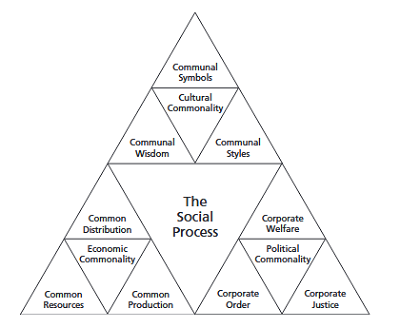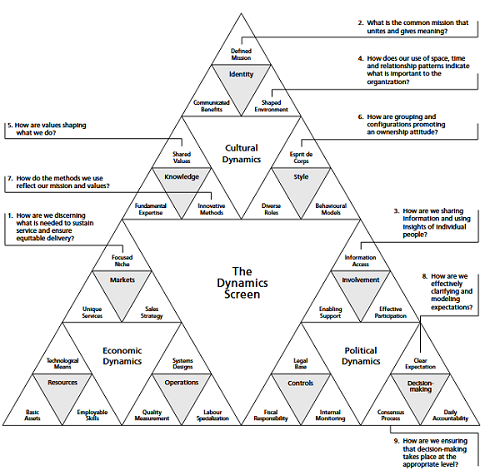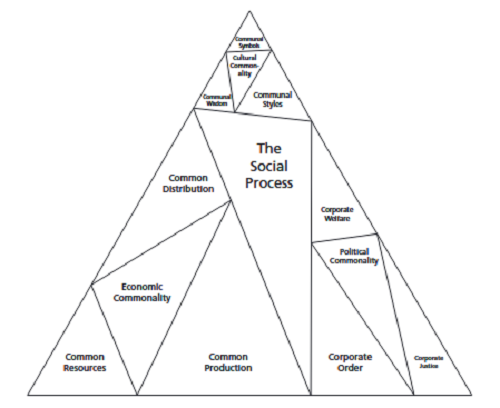Framework 154 Whole Systems Approach To Change (Triangular Format)
Introduction
Starting with social processes use a triangular format to illustrate how economic, political and cultural dimensions interact in change that operates at all levels, ie micro and macro; it is a useful tool to analyse a whole system:
"...Tensions between economic, political, and cultural tribes within a society or a group create imbalances that dramatically affect the everyday lives of people......form models a recursive pattern of drivers operating within any social system: foundational staining drivers (economic), ordering all organising drivers (political), meaning-giving or significant drivers (cultural). There is a corresponding implicit patterning of foundational, ordering, and meaning-giving drivers at every level of the triangle..."
Bill Staples, 2013

(source: Bill Staples, 2013)
Triangular approach
The triangle is broken down into a series of levels; each level represents increasing complexity and detail of organisational functions. For example: level I (economic, political and cultural); this is divided into 3 smaller triangles which are further divided into 3 smaller triangles, until you reach level 5.)
"...The intention is that each set of three triangles at any level can be described as in balance, a sort of ideal. In real life, there are always in balances and these imbalances are revealed when doing contradictional analysis..."
Bill Staples, 2013
The below diagram shows some of the levels:

(source: Bill Staples, 2013)
For example, the economic triangle's next level would include resources, production and distribution.
Diagram below shows social progress triangles (3rd level)

However, an imbalance can occur when one triangle dominates (see the diagram below where economic processes, especially production processes, dominate).

For example, where economic processes (especially production) are dominant; they can create tension with political and social processes, such as supercharged industrial process system attempting to control the social system through a weaker bureaucracy; with cultural institutions, mores and traditional wisdom may be overwhelmed by a production and consumption mentality. An instant of this would be a well-established farm production system attempting to maintain control of migrant workers using a police force.
Some more examples of imbalances:
- a logging town with no secondary industry and a few stores (a dominant resource system)
- a factory town with none of its own resources and few shopping opportunities (a dominant production system)
- a mall town with mall jobs, which outside people travel to for shopping but leave immediately after shopping because there is nothing else to keep them there, ie no resources nor production (a dominant distribution system)
These imbalances can cause great tension, especially if you attempt to redress the imbalance by paying more attention to other triangles, ie the basic problem will most likely compound.
"...putting time, energy, and resources into the collapsed triangle is a better strategy..."
Bill Staples, 2013
Some examples
- high-tech and new mining firms
"...have found that doing well financially (foundation is strongest) and having well-organised workplace (ordering is strong) still does not save them from absenteeism, lateness, and morale problems. Trying to solve this by rewarding the strongest performers with bigger individual bonuses can cause backstabbing and internal competition, while creating more workplace rules just increases resentment in the ranks and worsens morale. However, placing energy in the cultural dimensions, the new learning options, more staff social interaction, and a better understanding of how the company is helping society, can create positive change..."
Bill Staples, 2013
- communities with strong values
"...Communities around the world where religious convictions and values are very strong (meaning-giving his strongest), and local politics mirrors the religious conviction (order is strong), there is often an appalling abuse of the powerless and minority populations. Trying to impose ethical values or holding public meetings, the two sets of worse clashes and retribution happens. However, investing energy into the economic sector through micro-credit, skills training, and a barter system has changed the lives of millions for the better. Again, the indirect strategy of putting energy with a social process is the weakest pays off..."
Bill Staples, 2013
Summary
Identify imbalances in your organisation and focus attention on the weakest areas will have the most positive impact.
